A Floristic Analysis of Vascular Plants by the Disturbance Type and Application of Ecological Restoration Strategies in the Baekdudaegan Protected Area of South Korea
Abstract
1. Introduction
2. Materials and Methods
2.1. Study Area and Site Selection
2.2. Field Surveys and Plant Identification
2.3. Data Analysis and Index Calculations
- (A)
- Disturbance and Human Impact Indices.
- ▪
- Naturalized Index (NI) [46]:
- ▪
- Urbanization Index (UI) [47]:
- (B)
- Site Similarity Analysis.
- ▪
- Sørensen’s Similarity Index (Cs) [48]:
- (C)
- Multivariate Analysis.
- ▪
- Non-metric Multidimensional Scaling (NMDS) [49]:
- ▪
- .
- ▪
- .
- ▪
- .
- ▪
- ▪
- Similarity Percentage Analysis (SIMPER) [50]:
- ▪
- .
- ▪
- .
- ▪
- .
- ▪
- .
3. Results
3.1. Vegetation Characteristics of Disturbed Sites
3.1.1. Floristic Composition of Disturbed Sites
3.1.2. Endemic Plant Species in Disturbed Sites
3.1.3. Rare Plant Species in Disturbed Sites
3.1.4. Alien Plant and Invasive Plant Species in Disturbed Sites
3.2. Comparative Analysis of Naturalization Index (NI), Urbanization Index (UI), and Species Similarity of Disturbed Sites by Region and Disturbance Type
3.2.1. Comparison of NI and UI Between Disturbed Sites and Reference Ecosystems
3.2.2. Comparison of Sørensen Similarity Index Between Disturbed Sites and Reference Ecosystems by Region and Disturbance Type
3.3. Analysis Using Non-Metric Multidimensional Scaling (NMDS)
3.3.1. Analysis of Total Flora by Disturbed Site Type (NMDS and Cluster Analysis)
3.3.2. Analysis of Alien Plant Occurrence by Disturbed Site Type (NMDS and Cluster Analysis)
4. Discussion
4.1. Floristic Characteristics and Ecological Value of the Baekdudaegan Protected Area
4.2. Interpretation of Regional and Disturbance-Type Differences Based on Ecological Indices
4.3. Comparative Analysis of Plant Communities by Disturbance Type in the Baekdudaegan Protected Area
4.4. Site-Specific Restoration Strategies and Sustainable Management Approaches for Disturbed Sites in the Baekdudaegan Protected Area
5. Conclusions
Supplementary Materials
Author Contributions
Funding
Institutional Review Board Statement
Data Availability Statement
Conflicts of Interest
Appendix A
| Region | Address | Type |
|---|---|---|
| Mt. Jirisan region | Jeonbuk-do Namwon-si Ibaek-myeon Yangga-ri san 19-1 | A |
| Jeonbuk-do Namwon-si Ibaek-myeon Yangga-ri san 10 | B | |
| Jeonbuk-do Namwon-si Unbong-eup Janggyo-ri san 100-2 | B | |
| Jeonbuk-do Jangsu-gun Beonam-myeon Yujeong-ri san 276 | C | |
| Jeonbuk-do Jangsu-gun Beonam-myeon Yujeong-ri 236-5 | C | |
| Jeonbuk-do Namwon-si Ayeong-myeon Agok-ri san 86-10 | C | |
| Jeonbuk-do Jangsu-gun Beonam-myeon Yujeong-ri san 184 | B | |
| Jeonbuk-do Namwon-si Ayeong-myeon Agok-ri san 14 | A | |
| Jeonbuk-do Namwon-si Ayeong-myeon Inpung-ri san 13 | A | |
| Jeonbuk-do Jangsu-gun Beonam-myeon Nongok-ri san 91-2 | B | |
| Jeonbuk-do Namwon-si Ayeong-myeon Ildae-ri san 83 | A | |
| Jeonbuk-do Namwon-si Ayeong-myeon Ildae-ri san 85 | B | |
| Gyeongsangnam-do Hamyang-gun Baekjeon-myeon Unsan-ri 1168 | B | |
| Gyeongsangnam-do Hamyang-gun Baekjeon-myeon Unsan-ri 1181 | B | |
| Gyeongsangnam-do Hamyang-gun Seosang-myeon Sangnam-ri san 114-6 | A | |
| Gyeongsangnam-do Hamyang-gun Baekjeon-myeon Daean-ri san 225 | A | |
| Jeonbuk-do Jangsu-gun Beonam-myeon Yujeong-ri san 225 | A | |
| Jeonbuk-do Namwon-si Unbong-eup Chunhyang-ri san 22-10 | C | |
| Jeonbuk-do Namwon-si Unbong-eup Janggyo-ri san 114-3 | B | |
| Gyeongsangnam-do Hamyang-gun Baekjeon-myeon Daean-ri san 214 | C | |
| Mt. Deogyusan region | Chungcheongbuk-do Boeun-gun Songnisan-myeon Mansu-ri 9-2 | A |
| Gyeongsangbuk-do Sangju-si Hwanam-myeon Pyeong-on-ri san 30-1 | C | |
| Gyeongsangbuk-do Sangju-si Hwaseo-myeon Sanggok-ri 485-5 | A | |
| Gyeongsangbuk-do Sangju-si Hwaseo-myeon Sanggok-ri san 59-2 | C | |
| Gyeongsangbuk-do Sangju-si Hwaseo-myeon Sanggok-ri san 59-12 | C | |
| Gyeongsangbuk-do Sangju-si Hwadong-myeon Eosan-ri san 123 | C | |
| Gyeongsangbuk-do Sangju-si Moseo-myeon Seoksan-ri san 23 | B | |
| Gyeongsangbuk-do Sangju-si Moseo-myeon Sojeong-ri san 62 | E | |
| Gyeongsangbuk-do Sangju-si Moseo-myeon Daepo-ri san 107 | A | |
| Gyeongsangbuk-do Sangju-si Moseo-myeon Daepo-ri 216-1 | E | |
| Gyeongsangbuk-do Sangju-si Moseo-myeon Sojeong-ri san 84-1 | B | |
| Gyeongsangbuk-do Sangju-si Gongseong-myeon Bongsan-ri san 18-4 | A | |
| Gyeongsangbuk-do Gimcheon-si Daehang-myeon Jurye-ri san 127 | D | |
| Gyeongsangbuk-do Gimcheon-si Buhang-myeon Daeya-ri san 87-1 | B | |
| Jeonbuk-do Muju-gun Seolcheon-myeon Micheon-ri san 1 | C | |
| Gyeongsangbuk-do Gimcheon-si Buhang-myeon Eojeon-ri san 122-2 | A | |
| Gyeongsangnam-do Geochang-gun Goje-myeon Bonggye-ri 1077-2 | B | |
| Chungcheongbuk-do Yeongdong-gun Maegok-myeon Eochon-ri san 106-1 | I | |
| Gyeongsangbuk-do Gimcheon-si Daehang-myeon Unsu-ri san 84-1 | I | |
| Gyeongsangbuk-do Gimcheon-si Daehang-myeon Jurye-ri san 1 | I | |
| Gyeongsangbuk-do Sangju-si Hwaseo-myeon Sanggok-ri san 160-1 | D | |
| Gyeongsangbuk-do Sangju-si Hwadong-myeon Eosan-ri san 123 | C | |
| Gyeongsangbuk-do Sangju-si Hwadong-myeon Eosan-ri san 121 | D | |
| Gyeongsangbuk-do Sangju-si Hwaseo-myeon Sanggok-ri 508-1 | B | |
| Gyeongsangbuk-do Sangju-si Modong-myeon Deokgok-ri san 33 | B | |
| Gyeongsangbuk-do Gimcheon-si Eomo-myeon Neungchi-ri san 99 | B | |
| Chungcheongbuk-do Yeongdong-gun Maegok-myeon Okjeon-ri san 14-2 | B | |
| Gyeongsangbuk-do Sangju-si Hwaseo-myeon Sinbong-ri 20 | E | |
| Gyeongsangbuk-do Gimcheon-si Daehang-myeon Hyangcheon-ri san 163-1 | B | |
| Chungcheongbuk-do Yeongdong-gun Maegok-myeon Eochon-ri 18 | B | |
| Jeonbuk-do Muju-gun Mupung-myeon Geumpyeong-ri 263-13 | B | |
| Gyeongsangnam-do Geochang-gun Goje-myeon Bonggye-ri 1081 | B | |
| Gyeongsangnam-do Hamyang-gun Seosang-myeon Sangnam-ri san 9-1 | C | |
| Jeonbuk-do Jangsu-gun Janggye-myeon Myeongdeok-ri san 154-1 | A | |
| Mt. Songnisan region | Gyeongsangbuk-do Bonghwa-gun Chunyang-myeon Aedang-ri san 2 | B |
| Gyeongsangbuk-do Bonghwa-gun Chunyang-myeon Aedang-ri 923 | B | |
| Gyeongsangbuk-do Yeongju-si Punggi-eup Sucheol-ri 289 | B | |
| Chungcheongbuk-do Danyang-gun Daegang-myeon Sadong-ri san 1-1 | B | |
| Gyeongsangbuk-do Mungyeong-si Dongno-myeon Saengdal-ri san 3 | B | |
| Chungcheongbuk-do Jecheon-si Deoksan-myeon Dogi-ri san 102-4 | B | |
| Gyeongsangbuk-do Mungyeong-si Mungyeong-eup Gwaneum-ri san 92 | B | |
| Gyeongsangbuk-do Mungyeong-si Mungyeong-eup Jungpyeong-ri 485-2 | B | |
| Gyeongsangbuk-do Bonghwa-gun Chunyang-myeon Seokmundong-gil 418-2 | A | |
| Gyeongsangbuk-do Bonghwa-gun Chunyang-myeon Chamsaegol-gil 417-70 | A | |
| Gyeongsangbuk-do Yeongju-si Punggi-eup Sucheol-ri 418-1 | A | |
| Chungcheongbuk-do Danyang-gun Daegang-myeon Sadonggyegok-ro 202-40 | A | |
| Gyeongsangbuk-do Yecheon-gun Hyoja-myeon Yongdu-ri 10 | A | |
| Gyeongsangbuk-do Mungyeong-si Dongno-myeon Geumcheon-ro 2890-42 | A | |
| Gyeongsangbuk-do Mungyeong-si Mungyeong-eup Pyeongcheon-ri 669 | A | |
| Gyeongsangbuk-do Mungyeong-si Dongno-myeon Jeokseong-ri San 112-7 | D | |
| Gyeongsangbuk-do Yecheon-gun Hyoja-myeon Baekseok-gil 236-1 | D | |
| Gyeongsangbuk-do Yeongju-si Dansan-myeon Jwaseok-ri 194 | D | |
| Gyeongsangbuk-do Mungyeong-si Dongno-myeon Jeokseong-ri San 108-4 | E | |
| Gyeongsangbuk-do Mungyeong-si Mungyeong-eup Gwaneum-ri 605-1 | E | |
| Gyeongsangbuk-do Mungyeong-si Gaeun-eup Daeya-ro 826-19 | E | |
| Chungcheongbuk-do Goesan-gun Cheongcheon-myeon Samsong-ri 45-4 | E | |
| Gyeongsangbuk-do Bonghwa-gun Mulya-myeon Ojeon-ri 1-4 | C | |
| Gyeongsangbuk-do Mungyeong-si Mungyeong-eup Gwaneum-gil 555 | C | |
| Chungcheongbuk-do Goesan-gun Yeonpung-myeon Ihwaryeong-ro 561 | C | |
| Gyeongsangbuk-do Mungyeong-si Gaeun-eup Wanjang-ri San 63-25 | C | |
| Gyeongsangbuk-do Mungyeong-si Dongno-myeon Sangseok-gil 132-69 | G | |
| Chungcheongbuk-do Goesan-gun Yeonpung-myeon Jujin-ri 442 | G | |
| Chungcheongbuk-do Goesan-gun Cheongcheon-myeon Samsong-ri 1111-1111 | G | |
| Gyeongsangbuk-do Mungyeong-si Mungyeong-eup Pyeongcheon-ri 864 | A | |
| Gyeongsangbuk-do Bonghwa-gun Chunyang-myeon Aedang-ri san 2 | B | |
| Gyeongsangbuk-do Bonghwa-gun Chunyang-myeon Aedang-ri 923 | B | |
| Gyeongsangbuk-do Yeongju-si Punggi-eup Sucheol-ri 289 | B | |
| Chungcheongbuk-do Danyang-gun Daegang-myeon Sadong-ri san 1-1 | B | |
| Gyeongsangbuk-do Mungyeong-si Dongno-myeon Saengdal-ri san 3 | B | |
| Chungcheongbuk-do Jecheon-si Deoksan-myeon Dogi-ri san 102-4 | B | |
| Gyeongsangbuk-do Mungyeong-si Mungyeong-eup Gwaneum-ri san 92 | B | |
| Gyeongsangbuk-do Mungyeong-si Mungyeong-eup Jungpyeong-ri 485-2 | B | |
| Gyeongsangbuk-do Bonghwa-gun Chunyang-myeon Seokmundong-gil 418-2 | A | |
| Gyeongsangbuk-do Bonghwa-gun Chunyang-myeon Chamsaegol-gil 417-70 | A | |
| Gyeongsangbuk-do Yeongju-si Punggi-eup Sucheol-ri 418-1 | A | |
| Chungcheongbuk-do Danyang-gun Daegang-myeon Sadonggyegok-ro 202-40 | A | |
| Gyeongsangbuk-do Yecheon-gun Hyoja-myeon Yongdu-ri 10 | A | |
| Gyeongsangbuk-do Mungyeong-si Dongno-myeon Geumcheon-ro 2890-42 | A | |
| Gyeongsangbuk-do Mungyeong-si Mungyeong-eup Pyeongcheon-ri 669 | A | |
| Gyeongsangbuk-do Mungyeong-si Dongno-myeon Jeokseong-ri San 112-7 | D | |
| Gyeongsangbuk-do Yecheon-gun Hyoja-myeon Baekseok-gil 236-1 | D | |
| Gyeongsangbuk-do Yeongju-si Dansan-myeon Jwaseok-ri 194 | D | |
| Gyeongsangbuk-do Mungyeong-si Dongno-myeon Jeokseong-ri San 108-4 | E | |
| Gyeongsangbuk-do Mungyeong-si Mungyeong-eup Gwaneum-ri 605-1 | E | |
| Gyeongsangbuk-do Mungyeong-si Gaeun-eup Daeya-ro 826-19 | E | |
| Chungcheongbuk-do Goesan-gun Cheongcheon-myeon Samsong-ri 45-4 | E | |
| Gyeongsangbuk-do Bonghwa-gun Mulya-myeon Ojeon-ri 1-4 | C | |
| Gyeongsangbuk-do Mungyeong-si Mungyeong-eup Gwaneum-gil 555 | C | |
| Chungcheongbuk-do Goesan-gun Yeonpung-myeon Ihwaryeong-ro 561 | C | |
| Gyeongsangbuk-do Mungyeong-si Gaeun-eup Wanjang-ri San 63-25 | C | |
| Gyeongsangbuk-do Mungyeong-si Dongno-myeon Sangseok-gil 132-69 | G | |
| Chungcheongbuk-do Goesan-gun Yeonpung-myeon Jujin-ri 442 | G | |
| Chungcheongbuk-do Goesan-gun Cheongcheon-myeon Samsong-ri 1111-1111 | G | |
| Gyeongsangbuk-do Mungyeong-si Mungyeong-eup Pyeongcheon-ri 864 | A | |
| Mt. Taebaeksan region | Gangwon-do Taebaek-si Changjuk-dong 9-384 | B |
| Gangwon-do Pyeongchang-gun Daegwallyeong-myeon Hoenggye-ri San 1-119 | B | |
| Gangwon-do Gangneung-si Wangsan-myeon Mokgye-ri San 460-1 | B | |
| Gangwon-do Taebaek-si Gwinaemigol 1-gil 43 | A | |
| Gangwon-do Taebaek-si Hwajeon-dong 143-27 | A | |
| Gangwon-do Gangneung-si Okgye-myeon Sangye-ri San 347 | A | |
| Gangwon-do Pyeongchang-gun Daegwallyeong-myeon Hoenggye-ri San 2-1 | A | |
| Gangwon-do Gangneung-si Wangsan-myeon Daegi-ri San 1-12 | D | |
| Gangwon-do Gangneung-si Wangsan-myeon Wangsan-ri San 2-10 | D | |
| Gangwon-do Samcheok-si Hajang-myeon Beoncheon-ri San 57-2 | D | |
| Gangwon-do Gangneung-si Wangsan-myeon Mokgye-ri San 460-82 | D | |
| Gangwon-do Pyeongchang-gun Daegwallyeong-myeon Daegwallyeongmaru-gil 483-32 | H | |
| Gangwon-do Pyeongchang-gun Daegwallyeong-myeon Kkotbatyangji-gil 458-23 | H | |
| Gangwon-do Pyeongchang-gun Daegwallyeong-myeon Kkotbatyangji-gil 708-9 | H | |
| Gangwon-do Donghae-si Samhwa-dong 714 | E | |
| Gangwon-do Gangneung-si Seongsan-myeon Eoheul-ri San 1-29 | E | |
| Gangwon-do Taebaek-si Hasami-dong San 220-75 | E | |
| Gangwon-do Taebaek-si Sangsami-dong San 65-2 | C | |
| Gangwon-do Gangneung-si Wangsan-myeon Daegi-ri San 1-13 | C | |
| Gangwon-do Gangneung-si Wangsan-myeon Songhyeon-ri San 242-58 | C | |
| Gangwon-do Gangneung-si Wangsan-myeon Daegi-ri San 1-13 | C | |
| Gangwon-do Gangneung-si Wangsan-myeon Songhyeon-ri 86-1 | C | |
| Gangwon-do Gangneung-si Okgye-myeon Namyang-ri San 287 | G | |
| Gangwon-do Gangneung-si Yeongok-myeon Samsan-ri San 1-1 | G | |
| Gangwon-do Gangneung-si Wangsan-myeon Wangsan-ri San 1 | G | |
| Gangwon-do Pyeongchang-gun Daegwallyeong-myeon Byeongnae-ri San 1-2 | A | |
| Gangwon-do Pyeongchang-gun Daegwallyeong-myeon Byeongnae-ri 101-5 | C | |
| Gangwon-do Pyeongchang-gun Daegwallyeong-myeon Hoenggye-ri San 1-122 | D | |
| Gangwon-do Pyeongchang-gun Daegwallyeong-myeon Hoenggye-ri San 1-241 | A | |
| Gangwon-do Jeongseon-gun Imge-myeon Imge-ri San 8 | A | |
| Gangwon-do Samcheok-si Hajang-myeon Jungbong-ri San 1 | A | |
| Gangwon-do Pyeongchang-gun Daegwallyeong-myeon Kkotbatyangji-gil 458-23 | H | |
| Gangwon-do Taebaek-si Hasami-dong 524-45 | A | |
| Gangwon-do Gangneung-si Wangsan-myeon Daegi-ri 1948 | A | |
| Gangwon-do Gangneung-si Wangsan-myeon Songhyeon-ri San 242-63 | A | |
| Gangwon-do Taebaek-si Sangsami-dong San 65-2 | A | |
| Gangwon-do Gangneung-si Okgye-myeon Sangye-ri 1219-1 | A | |
| Gangwon-do Hongcheon-gun Nae-myeon Myeonggae-ri San 1-61 | D | |
| Gangwon-do Gangneung-si Yeongok-myeon Samsan-ri 1226-2 | A | |
| Gangwon-do Gangneung-si Seongsan-myeon Eoheul-ri San 1-36 | B | |
| Gangwon-do Hongcheon-gun Nae-myeon Myeonggae-ri San 1 | A | |
| Gangwon-do Taebaek-si Taebaeksan-ro 4150 | F | |
| Gangwon-do Samcheok-si Singi-myeon Daegi-ri San 2 | A | |
| Gangwon-do Hongcheon-gun Nae-myeon Myeonggae-ri 55-3 | A | |
| Gangwon-do Hongcheon-gun Nae-myeon Myeonggae-ri 5 | A | |
| Mt. Seoraksan region | Gangwon-do Goseong-gun Ganseong-eup Heulliryeong 1-gil 63 | F |
| Gangwon-do Goseong-gun Ganseong-eup Heulli San 45-5 | F | |
| Gangwon-do Hongcheon-gun Nae-myeon Myeongjigeori-gil 318 | F | |
| Gangwon-do Hongcheon-gun Nae-myeon Myeonggae-ri San 1-38 | F | |
| Gangwon-do Inje-gun Girin-myeon Jochimnyeong-ro 2250 | F | |
| Gangwon-do Goseong-gun Toseong-myeon Wonam-ri San 1-33 | F | |
| Gangwon-do Goseong-gun Ganseong-eup Heulli San 1-118 | B | |
| Gangwon-do Inje-gun Buk-myeon Yongdae-ri San 12-11 | B | |
| Gangwon-do Inje-gun Girin-myeon Jindong-ri 133-6 | B | |
| Gangwon-do Inje-gun Girin-myeon Seolpibat-gil 630-26 | B | |
| Gangwon-do Inje-gun Girin-myeon Jindong-ri 220 | B | |
| Gangwon-do Goseong-gun Ganseong-eup Heulli 20-34 | A | |
| Gangwon-do Inje-gun Girin-myeon Jindong-ri 189 | A | |
| Gangwon-do Inje-gun Girin-myeon Jindong-ri San 71 | A | |
| Gangwon-do Yangyang-gun Seo-myeon Seorim-ri San 1-5 | A | |
| Gangwon-do Hongcheon-gun Nae-myeon Myeonggae-ri San 1 | A | |
| Gangwon-do Goseong-gun Ganseong-eup Heulli San 1-92 | D | |
| Gangwon-do Goseong-gun Ganseong-eup Seonyusil-ri San 1 | D | |
| Gangwon-do Inje-gun Girin-myeon Jindong-ri San 71-79 | D | |
| Gangwon-do Yangyang-gun Seo-myeon Yeongdeok-ri San 81-1 | D | |
| Gangwon-do Yangyang-gun Seo-myeon Bukam-ri San 1 | D | |
| Gangwon-do Inje-gun Buk-myeon Yongdae-ri San 12-63 | D | |
| Gangwon-do Hongcheon-gun Nae-myeon Myeonggae-ri San 1 | E | |
| Gangwon-do Goseong-gun Toseong-myeon Wonam-ri San 1-1 | C | |
| Gangwon-do Yangyang-gun Seo-myeon Bukam-ri San 1 | A | |
| Gangwon-do Yangyang-gun Seo-myeon Osaek-ri San 1-75 | D |
| Family Name | Scientific Name | L-f | Orig. | Type | Degree | Freq. |
|---|---|---|---|---|---|---|
| Polygonaceae | Rumex acetosella L. * | Pe. | As, Eu | IAP (NP) | WS | 9 |
| Rumex crispus L. | Pe. | Af, As, Eu | IAP (NP) | WS | 6 | |
| Rumex obtusifolius L. | Pe. | Af, As, Eu | IAP (NP) | MS | 4 | |
| Amaranthaceae | Chenopodium album L. | 1 | As, Eu | IAP (NP) | CS | 28 |
| Oxybasis glauca (L.) S.Fuentes, Uotila & Borsch | 1 | As, Eu | IAP (NP) | SS | 1 | |
| Dysphania pumilio (R.Br.) Mosyakin & Clemants | 1 | Oc | IAP (NP) | PS | 1 | |
| Amaranthaceae | Amaranthus blitum subsp. Oleraceus (L.) Costea | 1 | Eu | Arc. | - | 3 |
| Phytolaccaceae | Phytolacca americana L. | Pe. | nA, sA | IAP (NP) | WS | 11 |
| Caryophyllaceae | Stellaria media (L.) Vill. | 1 | Af, As, Eu | IAP (NP) | WS | 1 |
| Brassicaceae | Thlaspi arvense L. | 2 | As, Eu | Arc. | - | 1 |
| Fabaceae | Lotus corniculatus L. | Pe. | Af, As, Eu | IAP (NP) | PS | 1 |
| Medicago lupulina L. | 2 | Af, As, Eu | IAP (NP) | MS | 1 | |
| Medicago sativa L. | Pe. | Eu | IAP (NP) | CS | 6 | |
| Trifolium hybridum L. | Pe. | As, Eu | IAP (NP) | PS | 1 | |
| Trifolium pratense L. | Pe. | Af, As, Eu | IAP (NP) | SS | 5 | |
| Trifolium repens L. | Pe. | Af | IAP (NP) | WS | 35 | |
| Geraniaceae | Geranium carolinianum L. | 1 | nA | IAP (NP) | PS | 1 |
| Oxalidaceae | Oxalis corniculata L. | Pe. | nA | Arc. | - | 14 |
| Euphorbiaceae | Euphorbia maculata L. | 1 | nA, sA | IAP (NP) | SS | 1 |
| Onagraceae | Oenothera biennis L. | 2 | nA | IAP (NP) | WS | 55 |
| Convolvulaceae | Cuscuta campestris Yunck. | 1 | nA, sA | IAP (NP) | CS | 1 |
| Solanaceae | Solanum nigrum L. | Pe. | Af, Eu | Arc. | - | 1 |
| Asteraceae | Ageratina altissima (L.) R.M.King & H.Rob. * | Pe. | nA | IAP (NP) | PS | 1 |
| Ambrosia artemisiifolia L. * | 1 | nA | IAP (NP) | WS | 16 | |
| Bidens frondosa L. | 1 | nA | IAP (NP) | WS | 28 | |
| Erigeron canadensis L. | 2 | nA, sA | IAP (NP) | WS | 65 | |
| Erechtites hieraciifolius (L.) Raf. ex DC. | 1 | nA, sA | IAP (NP) | WS | 3 | |
| Erigeron annuus (L.) Desf. | 2 | nA | IAP (NP) | WS | 106 | |
| Erigeron sumatrensis Retz. | 2 | sA | IAP (NP) | MS | 5 | |
| Erigeron philadelphicus L. | Pe. | nA | IAP (NP) | PS | 1 | |
| Erigeron strigosus Muhl. ex Willd. | 2 | nA | IAP (NP) | MS | 8 | |
| Galinsoga quadriradiata Ruiz & Pav. | 1 | nA, sA | IAP (NP) | WS | 23 | |
| Matricaria discoidea DC. | 1 | nA | IAP (NP) | PS | 1 | |
| Senecio vulgaris L. | 1 | As, Eu | IAP (NP) | SS | 4 | |
| Symphyotrichum pilosum (Willd.) G.L.Nesom * | Pe. | nA | IAP (NP) | SS | 15 | |
| Taraxacum officinale F.H. Wigg. | Pe. | Eu | IAP (NP) | WS | 41 | |
| Tragopogon dubius Scop. | 2 | As, Eu | IAP (NP) | PS | 1 | |
| Poaceae | Alopecurus pratensis L. | Pe. | As, Eu | IAP (NP) | PS | 1 |
| Bromus commutatus Schrad. | 2 | Af, As, Eu | IAP (CAP) | PS | 1 | |
| Dactylis glomerata L. | Pe. | As, Eu | IAP (NP) | WS | 8 | |
| Lolium arundinaceum (Schreb.) Darbysh. | Pe. | Af, As, Eu | IAP (NP) | SS | 5 | |
| Lolium multiflorum Lam. | 2 | As, Eu | IAP (NP) | CS | 1 | |
| Poa pratensis L. | Pe. | nA, As, Eu | IAP (NP) | SS | 7 | |
| Cannabaceae | Humulus scandens (Lour.) Merr. * | - | - | - | - | 41 |
References
- Hwang, S.H.; Lee, J.W.; La, E.H.; Ahn, J.K. Flora of the Vascular Plants of the Baekdudaegan Conservation Area: De-ok-chi to Yuk-sim-nyeong. Korean J. Plant Taxon. 2020, 50, 56–79. [Google Scholar] [CrossRef]
- Kim, D.H.; Oh, C.H. The Types and Structures of Forest Vegetation on the Baekdudaegan Protection Area in South Korea. Korean J. Environ. Ecol. 2024, 38, 515–529. [Google Scholar] [CrossRef]
- Song, J.H.; Kwon, J.O.; Yun, C.W. Forest Vegetation Structure in Maruguem (the Ridge Line) Area of Dakmokryeong to Daetjae, the Baekdudaegan. Korean J. Environ. Ecol. 2019, 33, 28–51. [Google Scholar] [CrossRef]
- Chung, M.Y.; Son, S.W.; Suh, G.U.; Herrando-Moraira, S.; Lee, C.H.; López-Pujol, J.; Chung, M.G. The Korean Baekdudaegan Mountains: A Glacial Refugium and a Biodiversity Hotspot That Needs to Be Conserved. Front. Genet. 2018, 9, 489. [Google Scholar] [CrossRef]
- Muellner-Riehl, A.N. Mountains as Evolutionary Arenas: Patterns, Emerging Approaches, Paradigm Shifts, and Their Implications for Plant Phylogeographic Research in the Tibeto-Himalayan Region. Front. Plant Sci. 2019, 10, 195. [Google Scholar] [CrossRef]
- Parker, J.G.; Vitt, D.H. Mountain Park: A Plant Refugium in the Canadian Rocky Mountains. Can. J. Bot. 1974, 52, 1393–1409. [Google Scholar]
- Parisod, C. Plant Speciation in the Face of Recurrent Climate Changes in the Alps. Alp. Bot. 2022, 132, 21–28. [Google Scholar] [CrossRef]
- Lee, H.J.; Kim, J.Y.; Nam, K.B.; An, J.H. The Survey on Actual Condition Depending on Type of Degraded Area and Suggestion for Restoration Species Based on Vegetation Information in the Mt. Jirisan Section of Baekdudaegan. Korean J. Environ. Ecol. 2020, 34, 558–572. [Google Scholar] [CrossRef]
- Lee, D.K.; Song, W.K.; Jeon, S.W.; Sung, H.C.; Son, D.Y. Deforestation Patterns Analysis of the Baekdudaegan Mountain Range. J. Korean Soc. Environ. Restor. Technol. 2007, 10, 41–53. [Google Scholar]
- Oh, H.K.; You, J.H. Vascular Plants of 4 Sections in Gangwon-do, Baekdudaegan Mountains. J. Korean Soc. Environ. Restor. Technol. 2018, 21, 43–63. [Google Scholar]
- Tang, L.; Shao, G.; Piao, Z.; Dai, L.; Jenkins, M.A.; Wang, S.; Wu, G.; Wu, J.; Zhao, J. Forest Degradation Deepens Around and Within Protected Areas in East Asia. Biol. Conserv. 2010, 143, 1295–1298. [Google Scholar] [CrossRef]
- Theobald, D.M.; Gonnell, H.; Riebsame, W.E. Land Use and Landscape Change in the Colorado Mountains II: A Case Study of the East River Valley. Mt. Res. Dev. 1996, 16, 407–418. [Google Scholar] [CrossRef]
- Qamer, F.M.; Shehzad, K.; Abbas, S.; Murthy, M.S.R.; Xi, C.; Gilani, H.; Bajracharya, B. Mapping Deforestation and Forest Degradation Patterns in Western Himalaya, Pakistan. Remote Sens. 2016, 8, 385. [Google Scholar] [CrossRef]
- Song, J.H.; Yun, C.W. Forest Vegetation Structure in Maruguem (the Ridge Line) Area of Gitdaebaegibong to Jukryeong, Baekdudaegan. J. Korean For. Sci. 2019, 108, 147–167. [Google Scholar]
- Kim, H.J.; Song, J.H.; Lee, J.E.; Cho, H.J.; Park, W.G.; Kim, S.J.; Yun, C.W. Forest Vegetation Structure around Marugeum (Ridge Line) Area in Deogyusan Region, Baekdudaegan. J. Korean Soc. For. Sci. 2022, 111, 81–99. [Google Scholar]
- Song, J.H.; Kim, H.J.; Lee, J.E.; Cho, H.J.; Park, W.G.; Yun, C.W. Phytosociological Vegetation Classification and Community Characteristics in Maruguem (the Ridge Line) Area of Mt. Jirisan (Yuksipryeong to Cheonwangbong), the Baekdudaegan. J. Korean For. Sci. 2022, 111, 19–35. [Google Scholar]
- Kim, Y.S.; Lee, M.W.; Han, G.I.; Heo, T.I.; Sung, C.Y.; Che, S.H. The Investigation of Damaged Sites in the Mt. Deogyusan Section of Baekdudaegan for Establishment Restoration Foundation. J. For. Environ. Sci. 2024, 40, 297–309. [Google Scholar]
- Lee, M.W.; Han, G.I.; Kim, Y.S.; Kim, S.B.; Heo, T.I. Ecological Strategy for Restoring the Forest Ecosystem in the Taebaek Region of Baekdudaegan Mountains in Korea. Forests 2025, 16, 383. [Google Scholar] [CrossRef]
- Kim, N.C.; Nam, U.J.; Shin, K.J. A Study on the Slope Ecological Restoration and Revegetation Models of the Baekdu-Mountain Range. J. Korean Soc. Environ. Restor. Technol. 2008, 11, 72–84. [Google Scholar]
- Lee, J.H.; Kwon, H.J.; Jeon, G.S.; Kim, N.C.; Park, G.S.; Song, H.K. Native Plants Selection for Ecological Replantation in Roadside Cutting-Slope of the Baekdu Range. J. Korean Soc. Environ. Restor. Technol. 2008, 11, 67–74. [Google Scholar]
- Ahn, T.M.; Kim, I.H.; Lee, J.Y.; Kim, C.K.; Chae, H.S.; Lee, Y.; Min, S.Y.; Kim, M.W. Development of Participatory Ecological Restoration System through Integrative Categorization of Disturbed Areas in Baekdudaegan. J. Korean Soc. Environ. Restor. Technol. 2009, 12, 11–22. [Google Scholar]
- Park, Y.D.; Kwon, T.H.; Ma, H.S. Ecological Monitoring on Changes in Microclimate, Vegetation and Soil Properties after 2 Years in Restoration Project Sites Linking the Ridgeline of Baekdudaegan. J. Agric. Life Sci. 2016, 50, 125–136. [Google Scholar] [CrossRef]
- Han, S.H.; Kim, J.H.; Kang, W.S.; Hwang, J.H.; Park, K.H.; Kim, C.B. Monitoring Soil Characteristics and Growth of Pinus densiflora Five Years after Restoration in the Baekdudaegan Ridge. Korean J. Environ. Ecol. 2019, 33, 453–461. [Google Scholar] [CrossRef]
- Kim, S.J.; Park, H.B. A Case Study on the Factors of Obstacles to Growth of Planted Trees in the Gimcheon Jakjumgogae of Baekdudaegan Ecological Axis Restoration Site. Korean J. Environ. Ecol. 2022, 36, 422–432. [Google Scholar] [CrossRef]
- Kim, Y.S.; Lim, D.O.; Oh, H.K.; Shin, H.T. Vascular Plants of Taebaeksan, Hambaeksan, Geumdaebong and Maebongsan in the Baekdudaegan. Korean J. Environ. Ecol. 2002, 15, 293–318. [Google Scholar]
- Kim, Y.S.; Lim, D.O.; Oh, H.K.; Ko, M.H. Vascular Plants of Gonamsan and Siribong in the Baekdudaegan. Korean J. Environ. Ecol. 2003, 16, 345–358. [Google Scholar]
- Lim, D.O.; Kim, Y.S.; Park, Y.K.; Ryu, Y.M. Vascular Plants of Manbokdae, Goribong and Sujeongbong in the Baekdudaegan. Korean J. Environ. Ecol. 2003, 16, 387–403. [Google Scholar]
- Lim, D.O.; Kim, Y.S.; Park, Y.K.; Ryu, Y.M.; Koh, M.H. Vascular Plants of Mt. Deogyu Area in the Baekdudaegan. Korean J. Environ. Ecol. 2004, 18, 107–122. [Google Scholar]
- Byeon, J.G.; Oh, S.H.; Lee, K.S.; Yun, J.E.; Jang, J.W.; Jeong, J.B.; Yang, J.C.; Kim, H.J. The Flora of Vascular Plants in Mt. Galjeongok-bong Protected Area for Forest Genetic Resource Conservation, Baekdudaegan, Korea. Korean J. Plant Res. 2014, 27, 477–484. [Google Scholar] [CrossRef]
- Jang, J.E.; Jeong, H.J.; Kim, Y.S.; Kim, J.E.; Lee, J.S.; Kim, A.; Park, B.K.; Jung, S.Y.; Gil, H.Y. The Flora of Vascular Plants in Bonghwasan Mountain (Namwon) of Baekdudaegan, Korea. Korean J. Environ. Ecol. 2023, 37, 235–250. [Google Scholar] [CrossRef]
- You, J.H.; Kim, M.J. Change of Flora of Damaged Land in Juwangsan National Park for Five Years (2010–2014). J. Environ. Impact Assess. 2016, 25, 233–247. [Google Scholar] [CrossRef]
- SERI. The SER International Primer on Ecological Restoration; Society for Ecological Restoration International Science & Policy Working Group: Madison, WI, USA, 2004; p. 102. [Google Scholar]
- Won, Y.J. Assessment of Restoration by Vegetation Community Using Reference Ecosystem. Ph.D. Thesis, Seoul National University, Seoul, Republic of Korea, 2020; p. 100. [Google Scholar]
- Korea Forest Service. Basic Plan for Baekdudaegan Conservation; Korea Forest Service: Seoul, Republic of Korea, 2016; p. 91.
- Lee, T.B. Coloured Flora of Korea; Hyangmunsa: Seoul, Republic of Korea, 2003; p. 901+914. [Google Scholar]
- Cho, Y.H.; Kim, J.H.; Park, S.H. Grasses and Sedges in South Korea; Geobook: Seoul, Republic of Korea, 2016; p. 527. [Google Scholar]
- Lee, C.S.; Lee, K.H. Pteridophytes of Korea: Lycophytes & Ferns, 2nd ed.; Geobook: Seoul, Republic of Korea, 2018; p. 492. [Google Scholar]
- Gil, H.Y.; Kim, D.K.; Kim, H.J.; Chang, K.S.; Choi, K.; Oh, S.H. Illustrated Juncaceae·Eriocaulaceae·Typhaceae of Korea; Korea National Arboretum: Pocheon, Republic of Korea, 2019; p. 255. [Google Scholar]
- POWO 2025. Plants of the World Online. Facilitated by the Royal Botanic Gardens, Kew. Available online: http://www.plantsoftheworldonline.org/ (accessed on 10 May 2025).
- Korea National Arboretum. Checklist of Vascular Plants in Korea (Native Plants). Available online: http://www.nature.go.kr/kpni (accessed on 15 January 2025).
- Korea National Arboretum. Checklist of Vascular Plants in Korea (Alien Plants). Available online: http://www.nature.go.kr/kpni (accessed on 15 January 2025).
- Chung, G.Y.; Jang, H.D.; Chang, K.S.; Choi, H.J.; Kim, Y.S.; Kim, H.J.; Son, D.C. A Checklist of Endemic Plants on the Korean Peninsula II. Korean J. Plant Taxon. 2023, 53, 79–101. [Google Scholar] [CrossRef]
- Korea National Arboretum. The National Red List of Vascular Plants in Korea; Korea National Arboretum: Pocheon, Republic of Korea, 2021; p. 423. [Google Scholar]
- Kang, E.S.; Lee, S.R.; Oh, S.H.; Kim, D.K.; Jung, S.Y.; Son, D.C. Comprehensive Review about Alien Plants in Korea. Korean J. Plant Taxon. 2020, 50, 89–119. [Google Scholar] [CrossRef]
- Ministry of Environment. Appoint Notice of Ecosystem Disturbance Wild Plant. Available online: https://www.me.go.kr (accessed on 15 January 2025).
- Numata, M. Naturalized Plants; Dai Nippon Printing: Tokyo, Japan, 1975; p. 160. [Google Scholar]
- Yim, Y.J.; Jeon, E.S. Distribution of Naturalized Plants in the Korean Peninsula. J. Plant Biol. 1981, 23, 69–83. [Google Scholar]
- Sorensen, T.A. A Method of Establishing Groups of Equal Amplitude in Plant Sociology Based on Similarity of Species Content and Its Application to Analyses of the Vegetation on Danish Commons. Biol. Skr. 1948, 5, 1–34. [Google Scholar]
- Bray, J.R.; Curtis, J.T. An Ordination of the Upland Forest Communities of Southern Wisconsin. Ecol. Monogr. 1957, 27, 325–349. [Google Scholar] [CrossRef]
- Clarke, K.R. Non-parametric Multivariate Analyses of Changes in Community Structure. Aust. J. Ecol. 1993, 18, 117–143. [Google Scholar] [CrossRef]
- Körner, C. Concepts in Alpine Plant Ecology. Plants 2023, 12, 2666. [Google Scholar] [CrossRef] [PubMed]
- Zine, H.; Hakkou, R.; Elmansour, A.; Elgadi, S.; Ouhammou, A.; Benzaazoua, M. Native Plant Diversity for Ecological Reclamation in Moroccan Open-Pit Phosphate Mines. Biodivers. Data J. 2023, 11, e104592. [Google Scholar] [CrossRef]
- Wani, I.A.; Verma, S.; Gupta, R.; Ganaie, M.M.; Nigam, G.; Shafik, H.M.; Al-Misned, F.A. Nutrient Analysis and Species Diversity of Alpine Grasslands: A Comparative Analysis of Less Studied Biodiversity Hotspots. Sustainability 2022, 14, 887. [Google Scholar] [CrossRef]
- Finch, D.M.; Butler, J.L.; Runyon, J.B.; Fettig, C.J.; Kilkenny, F.F.; Jose, S.; Frankel, S.J.; Cushman, S.A.; Cobb, R.C.; Dukes, J.S.; et al. Effects of Climate Change on Invasive Species. In Invasive Species in Forests and Rangelands of the United States; Springer: New York, NY, USA, 2021; pp. 57–83. [Google Scholar]
- Vitasse, Y.; Ursenbacher, S.; Klein, G.; Bohnenstengel, T.; Chittaro, Y.; Delestrade, A.; Monnerat, C.; Rebetez, M.; Rixen, C.; Strebel, N.; et al. Phenological and Elevational Shifts of Plants, Animals and Fungi under Climate Change in the European Alps. Biol. Rev. 2021, 96, 1816–1835. [Google Scholar] [CrossRef] [PubMed]
- Mathakutha, R.; Steyn, C.; le Roux, P.C.; Blom, I.J.; Chown, S.L.; Daru, B.H.; Ripley, B.S.; Louw, A.; Greve, M. Invasive Species Differ in Key Functional Traits from Native and Non-invasive Alien Plant Species. J. Veg. Sci. 2019, 30, 994–1006. [Google Scholar] [CrossRef]
- Seitz, T.J.; Spellman, K.V.; Mulder, C.P. Wildfire and Invasive Plants in Alaska’s Boreal Forest. J. For. Ecol. 2024; in press. [Google Scholar]
- Seebens, H.; Essl, F.; Hulme, P.E.; van Kleunen, M. Development of Pathways of Global Plant Invasions in Space and Time. In Global Plant Invasions; Springer International Publishing: Cham, Switzerland, 2022; pp. 53–69. [Google Scholar]
- Falk, D.A.; van Mantgem, P.J.; Keeley, J.E.; Gregg, R.M.; Guiterman, C.H.; Tepley, A.J.; Young, D.J.N.; Marshall, L.A. Mechanisms of Forest Resilience. For. Ecol. Manag. 2022, 512, 120129. [Google Scholar] [CrossRef]
- Kaur, A.; Sharma, A.; Kaur, S.; Siddiqui, M.H.; Alamri, S.; Ahmad, M.; Kohli, R.K.; Singh, H.P.; Batish, D.R. Role of Plant Functional Traits in the Invasion Success: Analysis of Nine Species of Asteraceae. BMC Plant Biol. 2024, 24, 784. [Google Scholar] [CrossRef]
- Potgieter, L.J.; Gaertner, M.; O’Farrell, P.J.; Richardson, D.M. Perceptions of Impact: Invasive Alien Plants in the Urban Environment. J. Environ. Manag. 2019, 229, 76–87. [Google Scholar] [CrossRef]
- Chang, C.C.; Halpern, C.B.; Antos, J.A.; Avolio, M.L.; Biswas, A.; Cook, J.E.; del Moral, R.; Fischer, D.G.; Holz, A.; Pabst, R.J.; et al. Testing Conceptual Models of Early Plant Succession Across a Disturbance Gradient. J. Ecol. 2019, 107, 517–530. [Google Scholar] [CrossRef]
- Holl, K.D.; Aide, T.M. When and Where to Actively Restore Ecosystems? For. Ecol. Manag. 2011, 261, 1558–1563. [Google Scholar] [CrossRef]
- Navarro-Ramos, S.E.; Sparacino, J.; Rodríguez, J.M.; Filippini, E.; Marsal-Castillo, B.E.; García-Cannata, L.; Renison, D.; Torres, R.C. Active Revegetation after Mining: What Is the Contribution of Peer-reviewed Studies? Heliyon 2022, 8, e09179. [Google Scholar] [CrossRef]
- Royer-Tardif, S.; Bauhus, J.; Doyon, F.; Nolet, P.; Thiffault, N.; Aubin, I. Revisiting the Functional Zoning Concept under Climate Change to Expand the Portfolio of Adaptation Options. Forests 2021, 12, 273. [Google Scholar] [CrossRef]
- Nelson, C.R.; Hallett, J.G.; Romero Montoya, A.E.; Andrade, A.; Besacier, C.; Boerger, V.; Bouazza, K.; Chazdon, R.; Cohen-Shacham, E.; Danano, D.; et al. Standards of Practice to Guide Ecosystem Restoration: A Contribution to the United Nations Decade on Ecosystem Restoration 2021–2030; Food & Agriculture Organization: Rome, Italy, 2024. [Google Scholar]

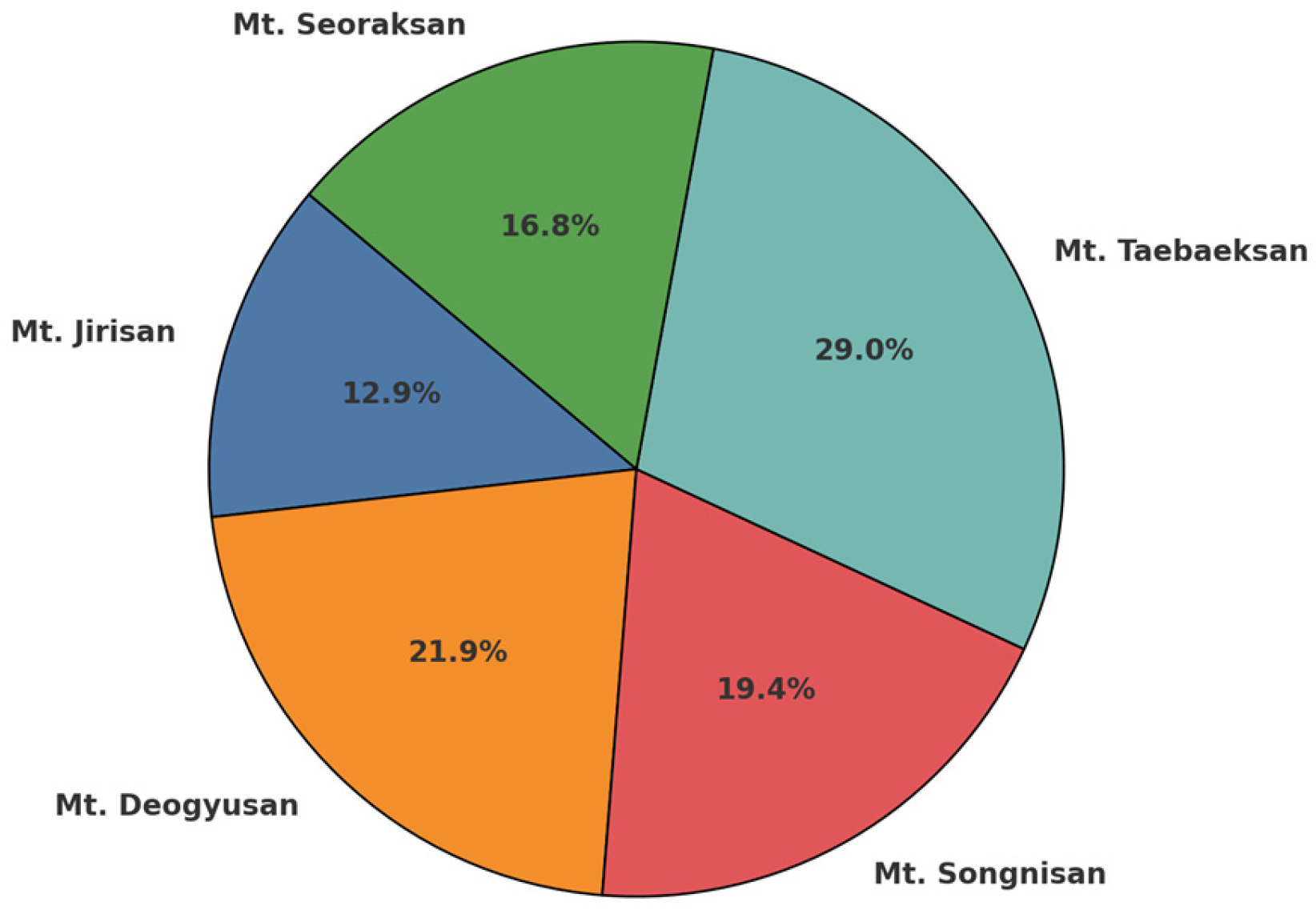
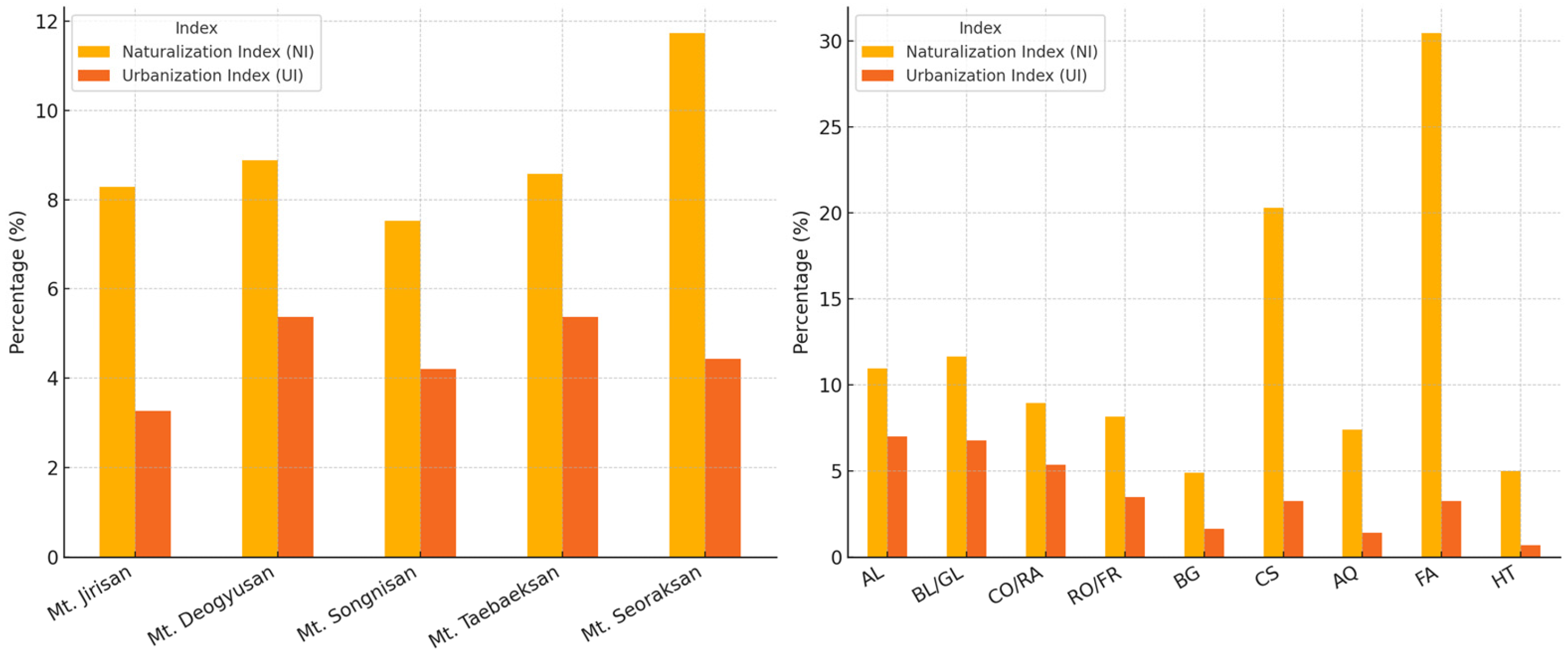

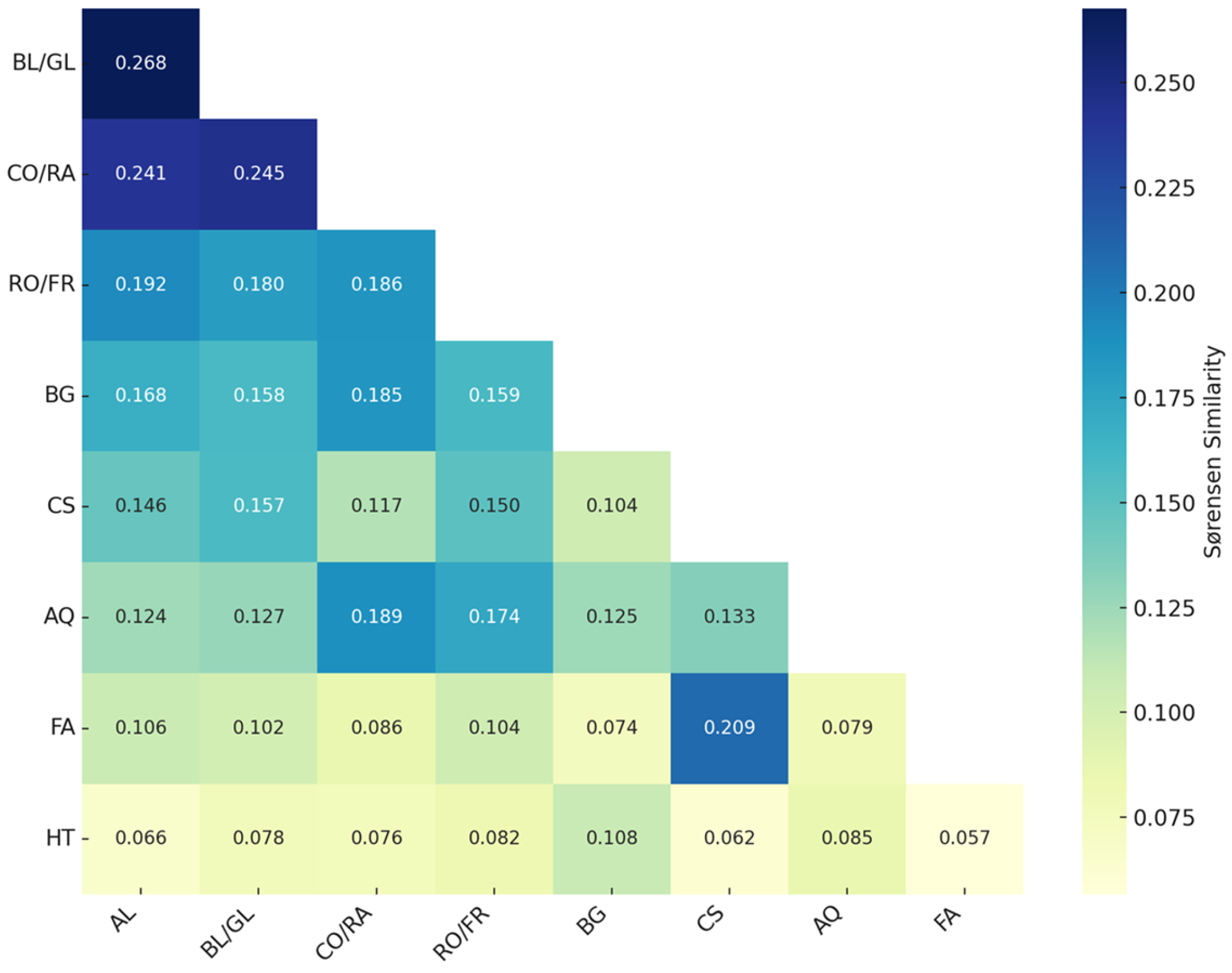
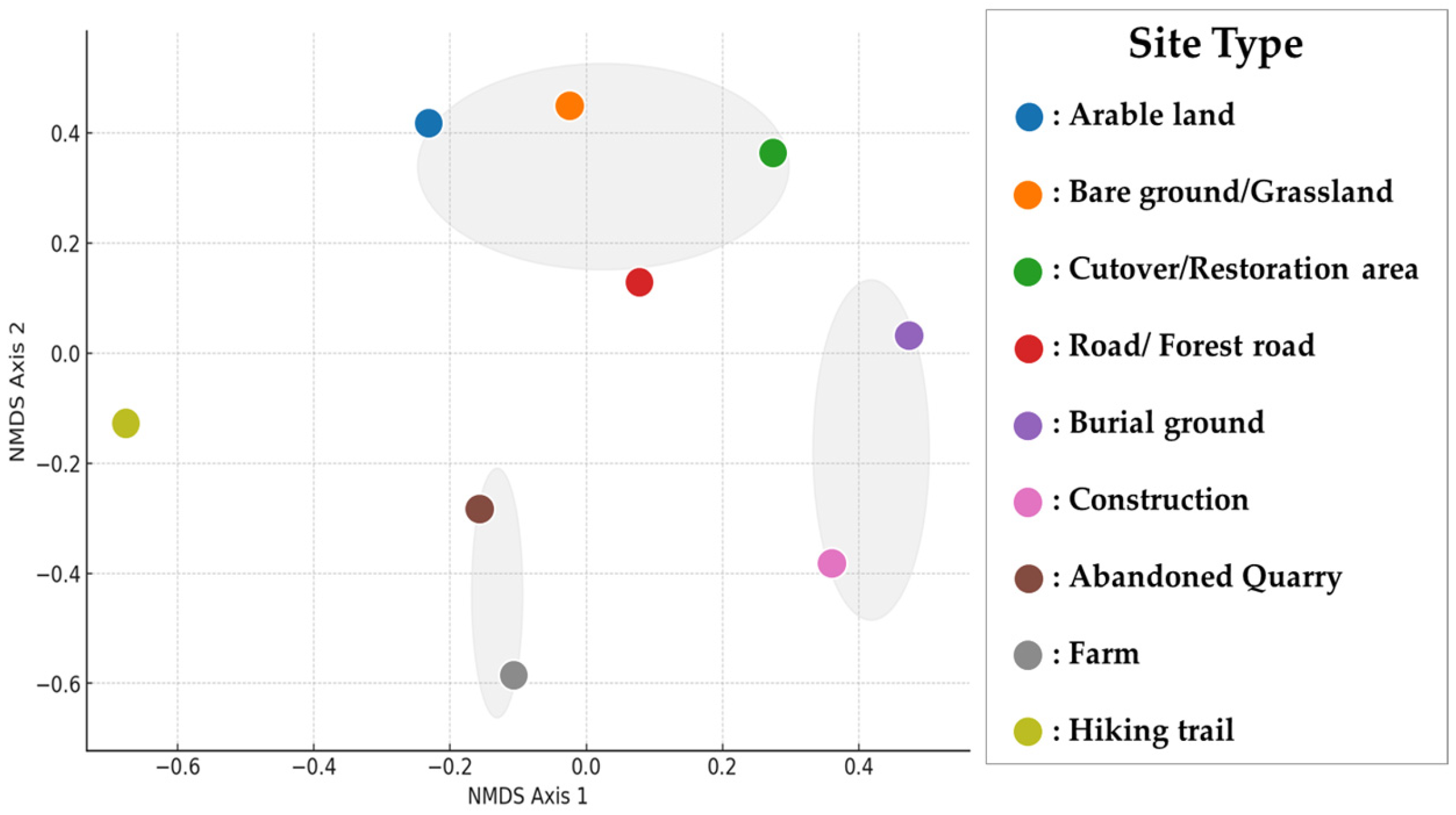

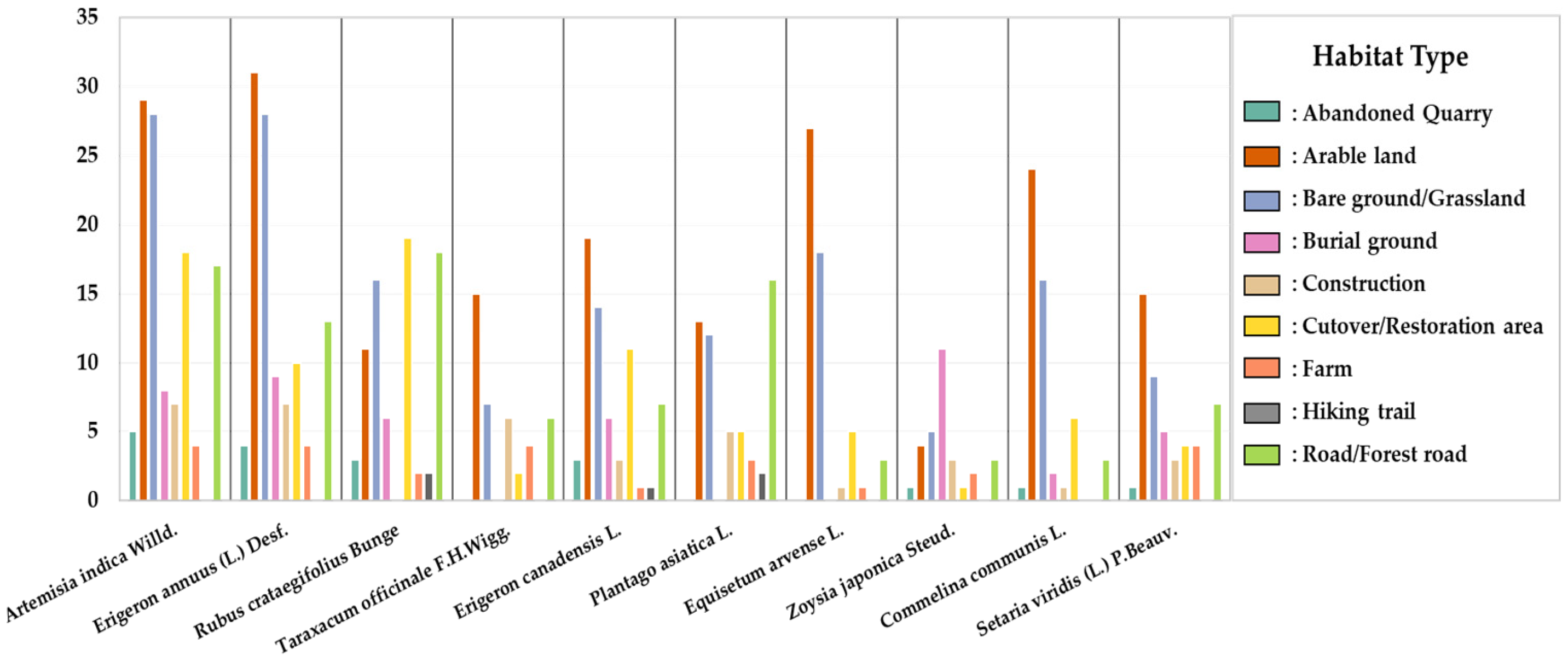

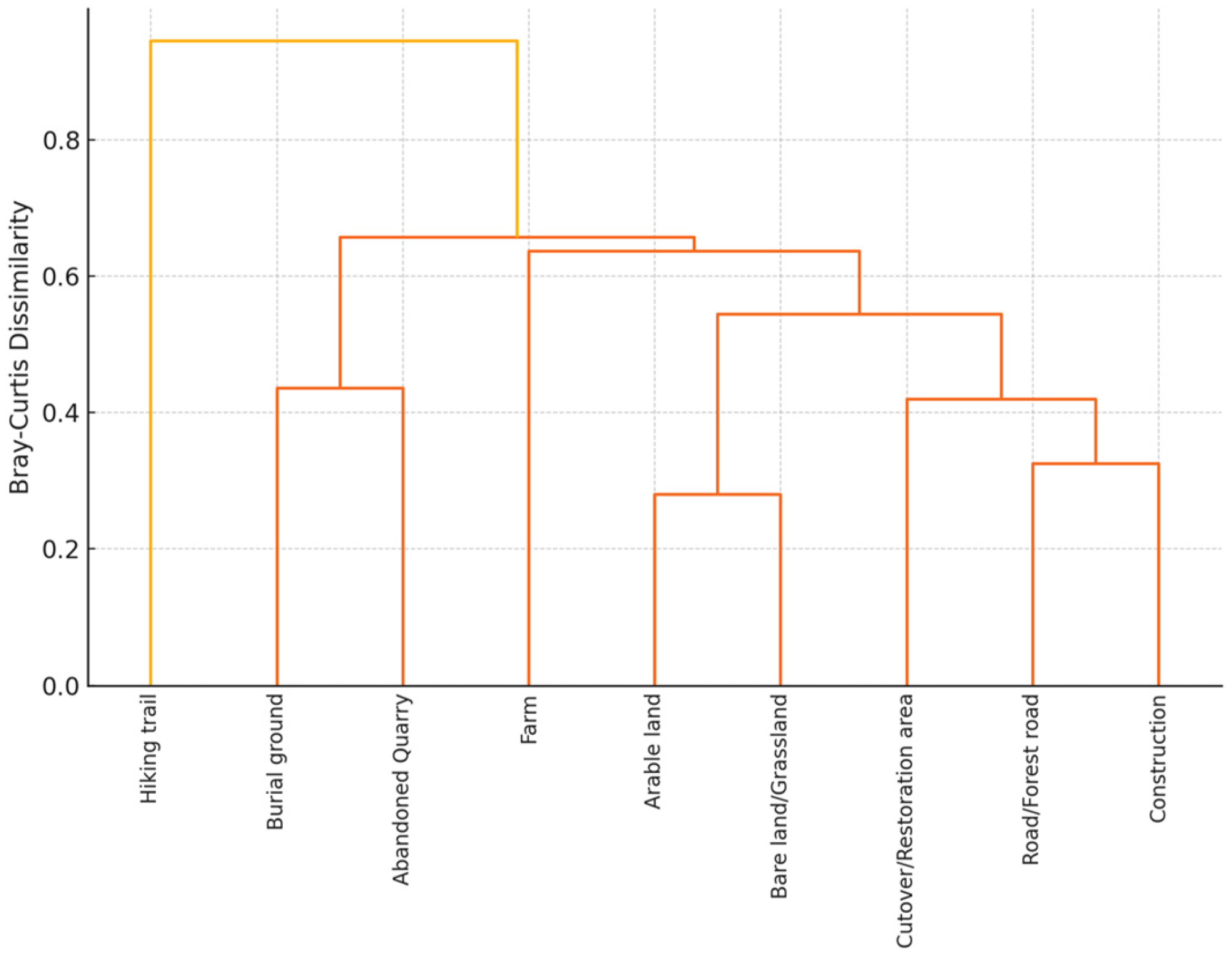

| Location | AL | BL/GL | CO/RA | RO/FR | BG | CS | AQ | FA | HT |
|---|---|---|---|---|---|---|---|---|---|
| Mt. Jirisan | 7 | 8 | 5 | - | - | - | - | - | - |
| Mt. Deogyusan | 6 | 12 | 7 | 3 | 3 | - | - | - | 3 |
| Mt. Songnisan | 8 | 8 | 4 | 3 | 4 | - | 3 | - | - |
| Mt. Taebaeksan | 18 | 4 | 6 | 6 | 3 | 1 | 3 | 4 | - |
| Mt. Seoraksan | 6 | 5 | 1 | 7 | 1 | 6 | - | - | - |
| Total | 45 | 37 | 23 | 19 | 11 | 7 | 6 | 4 | 3 |
| Taxa | Family | Genus | Species | Subspecies | Variety | Forma | Hybrid | Total |
|---|---|---|---|---|---|---|---|---|
| Pteridophyta | 6 | 11 | 14 | - | - | - | - | 14 |
| Gymnospermae | 2 | 5 | 7 | - | - | - | - | 7 |
| Angiospermae | 81 | 287 | 459 | 15 | 16 | 1 | 3 | 494 |
| Dicotyledons | 72 | 228 | 358 | 13 | 13 | 1 | 2 | 387 |
| Monocotyledons | 9 | 59 | 101 | 2 | 3 | - | 1 | 107 |
| Total | 89 | 303 | 480 | 15 | 16 | 1 | 3 | 515 |
| Family Name | Scientific Name | Freq. |
|---|---|---|
| Salicaceae | Populus × tomentiglandulosa T.B.Lee | 6 |
| Ranunculaceae | Anemone koraiensis Nakai | 3 |
| Clematis trichotoma Nakai | 1 | |
| Clematis heracleifolia DC. (KNA: Clematis urticifolia Nakai ex Kitag.) | 1 | |
| Apiaceae | Angelica genuflexa Nutt. (KNA: Angelica reflexa B.Y.Lee) | 1 |
| Oleaceae | Forsythia koreana (Rehder) Nakai | 1 |
| Caprifoliaceae | Weigela subsessilis (Nakai) L.H.Bailey | 6 |
| Caprifoliaceae | Patrinia saniculifolia Hemsl. | 1 |
| Asteraceae | Aster koraiensis Nakai | 4 |
| Cirsium setidens (Dunn) Nakai | 2 | |
| Cyperaceae | Carex gifuensis Franch. (KNA: Carex fusanensis Ohwi) | 1 |
| Asphodelaceae | Hemerocallis hakuunensis Nakai | 3 |
| Family | Scientific Name | Degree | Freq. |
|---|---|---|---|
| Apiaceae | Bupleurum euphorbioides Nakai | EN | 1 |
| Ericaceae | Rhododendron micranthum Turcz. | NT | 2 |
| Primulaceae | Lysimachia pentapetala Bunge | VU | 1 |
| Phrymaceae | Erythranthe tenellus (Bunge) G.L.Nesom | NT | 1 |
Disclaimer/Publisher’s Note: The statements, opinions and data contained in all publications are solely those of the individual author(s) and contributor(s) and not of MDPI and/or the editor(s). MDPI and/or the editor(s) disclaim responsibility for any injury to people or property resulting from any ideas, methods, instructions or products referred to in the content. |
© 2025 by the authors. Licensee MDPI, Basel, Switzerland. This article is an open access article distributed under the terms and conditions of the Creative Commons Attribution (CC BY) license (https://creativecommons.org/licenses/by/4.0/).
Share and Cite
Kim, Y.-S.; Han, G.-I.; Kim, S.-B.; Lee, M.-W.; Song, S.-K.; Kim, S.-G.; Heo, T.-I. A Floristic Analysis of Vascular Plants by the Disturbance Type and Application of Ecological Restoration Strategies in the Baekdudaegan Protected Area of South Korea. Diversity 2025, 17, 378. https://doi.org/10.3390/d17060378
Kim Y-S, Han G-I, Kim S-B, Lee M-W, Song S-K, Kim S-G, Heo T-I. A Floristic Analysis of Vascular Plants by the Disturbance Type and Application of Ecological Restoration Strategies in the Baekdudaegan Protected Area of South Korea. Diversity. 2025; 17(6):378. https://doi.org/10.3390/d17060378
Chicago/Turabian StyleKim, Young-Soo, Gyu-Il Han, Seong-Bin Kim, Min-Woo Lee, Se-Kyu Song, Sang-Geun Kim, and Tae-Im Heo. 2025. "A Floristic Analysis of Vascular Plants by the Disturbance Type and Application of Ecological Restoration Strategies in the Baekdudaegan Protected Area of South Korea" Diversity 17, no. 6: 378. https://doi.org/10.3390/d17060378
APA StyleKim, Y.-S., Han, G.-I., Kim, S.-B., Lee, M.-W., Song, S.-K., Kim, S.-G., & Heo, T.-I. (2025). A Floristic Analysis of Vascular Plants by the Disturbance Type and Application of Ecological Restoration Strategies in the Baekdudaegan Protected Area of South Korea. Diversity, 17(6), 378. https://doi.org/10.3390/d17060378






